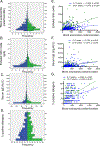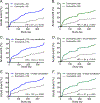Exploring the Utility of Noninvasive Type 2 Inflammatory Markers for Prediction of Severe Asthma Exacerbations in Children and Adolescents
- PMID: 31100552
- PMCID: PMC6842678
- DOI: 10.1016/j.jaip.2019.04.043
Exploring the Utility of Noninvasive Type 2 Inflammatory Markers for Prediction of Severe Asthma Exacerbations in Children and Adolescents
Abstract
Background: Noninvasive markers of type 2 inflammation are needed to identify children and adolescents who might benefit from personalized biologic therapy.
Objective: We hypothesized that blood eosinophil counts would predict 1 or more acute visits for asthma and that prediction could be improved with the addition of a second, noninvasive type 2 inflammatory biomarker.
Methods: Children and adolescents 5 to 21 years (N = 589) with an asthma exacerbation necessitating systemic corticosteroid treatment in the previous year completed a characterization visit and telephone calls at 6 and 12 months. The primary outcome was an acute visit for asthma with receipt of systemic corticosteroids. Acute visits were verified by medical record review. Exploratory outcomes included time to first acute visit and hospitalization.
Results: Acute visits occurred in 106 (35.5%) children and 72 (24.8%) adolescents. Elevated blood eosinophils were associated with increased odds and shorter time to first acute visit, but optimal cut-points differed by age (≥150 vs ≥300 cells/μL for children vs adolescents, respectively). The addition of a second marker of type 2 inflammation did not improve prediction in children, but increased the odds and hazard of an acute visit up to 16.2% and 11.9%, respectively, in adolescents. Similar trends were noted for hospitalizations.
Conclusions: Blood eosinophils and other noninvasive markers of type 2 inflammation may be useful in the clinical assessment of children and adolescents with asthma. However, features of type 2 inflammation vary by age. Whether children and adolescents also respond differently to management of type 2 inflammation is unclear and warrants further evaluation.
Keywords: Allergic sensitization; Asthma control; Asthma exacerbation; Biomarker; Eosinophil; Type 2 inflammation.
Copyright © 2019 American Academy of Allergy, Asthma & Immunology. Published by Elsevier Inc. All rights reserved.
Figures


References
-
- Fischer GB, Sarria EE, Camargos P, Mocelin HT, Soto-Quiroz M, Cruz AA, et al. Childhood asthma in low and middle-income countries: Where are we now? Paediatr Respir Rev 2018. - PubMed
-
- Sullivan PW, Ghushchyan V, Navaratnam P, Friedman HS, Kavati A, Ortiz B, et al. National Prevalence of Poor Asthma Control and Associated Outcomes Among School-Aged Children in the United States. J Allergy Clin Immunol Pract 2018; 6:536–44 e1. - PubMed
-
- 2016 National Health Interview Survey (NHIS) Data, Centers for Disease Control and Prevention. Available at http://www.cdc.gov/asthma/most_recent_data.htm. Last accessed February 26, 2019.
-
- Kodjebacheva GD, Sabo T, Parker S. Influences of asthma on reported health indicators and access to health care among children. Ann Allergy Asthma Immunol 2016; 116:126–33. - PubMed
-
- Kit BK, Simon AE, Ogden CL, Akinbami LJ. Trends in preventive asthma medication use among children and adolescents, 1988–2008. Pediatrics 2012; 129:62–9. - PubMed

